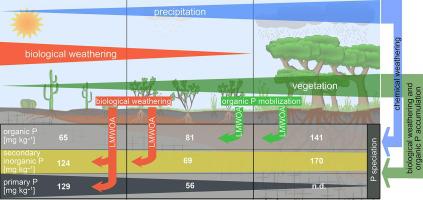Our official English website, www.x-mol.net, welcomes your feedback! (Note: you will need to create a separate account there.)
From rock eating to vegetarian ecosystems — Disentangling processes of phosphorus acquisition across biomes
Geoderma ( IF 6.1 ) Pub Date : 2020-11-01 , DOI: 10.1016/j.geoderma.2020.114827 Moritz Koester , Svenja C. Stock , Francisco Nájera , Khaled Abdallah , Anna Gorbushina , Jörg Prietzel , Francisco Matus , Wantana Klysubun , Jens Boy , Yakov Kuzyakov , Michaela A. Dippold , Sandra Spielvogel
Geoderma ( IF 6.1 ) Pub Date : 2020-11-01 , DOI: 10.1016/j.geoderma.2020.114827 Moritz Koester , Svenja C. Stock , Francisco Nájera , Khaled Abdallah , Anna Gorbushina , Jörg Prietzel , Francisco Matus , Wantana Klysubun , Jens Boy , Yakov Kuzyakov , Michaela A. Dippold , Sandra Spielvogel

|
Abstract Low-molecular-weight organic acids (LMWOAs) are crucial for the mobilization and acquisition of mineral phosphorus by plants. However, the role of LMWOAs in mobilizing organic phosphorus, which is the predominant phosphorus form in at least half of the world's ecosystems, especially in humid climates, is unclear. The mechanisms of phosphorus mobilization by LMWOAs depend on climate, mainly precipitation, and shape the phosphorus nutrition strategies of plants. We disentangled the impact of roots and associated microorganisms on mechanisms of phosphorus cycling mediated by LMWOAs by studying soils along an ecosystem-sequence (ecosequence) from arid shrubland (~70 mm yr−1), and Mediterranean woodland (~370 mm yr−1) to humid-temperate forest (~1470 mm yr−1). Phosphorus speciation in soil was examined by X-ray absorption near edge structure analysis (XANES). LMWOAs were quantified as biological rock-weathering and organic phosphorus mobilization agents and compared to kinetics of acid phosphatase as a proxy for organic phosphorus mineralization. Calcium-bound phosphorus in topsoils decreased from 126 mg kg−1 in the arid shrubland, to 19 mg kg−1 in the Mediterranean woodland and was undetectable in the humid-temperate forest. In contrast, organic phosphorus in topsoils in close root proximity (0–2 mm distance to roots) was absent in the arid shrubland but raised to 220 mg kg−1 in the Mediterranean woodland and to 291 mg kg- 1 in the humid-temperate forest. The organic phosphorus content in topsoils was 1.6 to 2.4 times higher in close root proximity (0–2 mm distance to roots) compared to bulk soil (4–6 mm distance to roots) in the Mediterranean woodland and humid-temperate forest, showing intensive phosphorus bioaccumulation in the rhizosphere. Redundancy analysis (RDA) revealed that LMWOAs were explained by the content of hydroxyapatite and variscite phosphorus-species in the arid shrubland, indicating that LMWOAs contribute to mineral weathering in this soil. LMWOA contents, phosphatase activity, and microbial biomass carbon correlated strongly with organic phosphorus in the humid-temperate forest soil, which implies a high relevance of LMWOAs for organic phosphorus recycling. In the Mediterranean woodland soil, however, oxalic acid correlated with organic phosphorus in the topsoil (suggesting phosphorus recycling), whereas in the subsoil malic and citric acid were correlated with primary and secondary phosphorus minerals (implying mineral weathering). We conclude that phosphorus acquisition and cycling depend strongly on climate and that the functions of LMWOAs in the rhizosphere change fundamentally along the precipitation gradient. In the arid shrubland LMWOAs facilitate biochemical weathering (rock eating), while in the humid-temperate forest their functions change towards supporting organic phosphorus recycling (vegetarian).
中文翻译:

从吃岩石到素食生态系统——解开生物群落中磷获取的过程
摘要 低分子量有机酸 (LMWOA) 对于植物对矿物磷的动员和获取至关重要。然而,LMWOA 在动员有机磷方面的作用尚不清楚,有机磷是世界上至少一半生态系统中的主要磷形式,特别是在潮湿气候中。LMWOA 的磷动员机制取决于气候,主要是降水,并影响植物的磷营养策略。我们通过研究来自干旱灌木地(~70 mm yr-1)和地中海林地(~370 mm yr-1)的生态系统序列(生态序列)的土壤,解开了根和相关微生物对 LMWOA 介导的磷循环机制的影响) 到湿温带森林 (~1470 mm yr−1)。通过 X 射线吸收近边结构分析 (XANES) 检查土壤中的磷形态。LMWOA 被量化为生物岩石风化剂和有机磷动员剂,并与酸性磷酸酶的动力学进行比较,作为有机磷矿化的代表。表土中的钙结合磷从干旱灌木地的 126 mg kg-1 下降到地中海林地的 19 mg kg-1,并且在湿温带森林中检测不到。相比之下,在干旱灌木林中,靠近根部(距根部 0-2 毫米距离)的表土中的有机磷不存在,但在地中海林地中升高至 220 mg kg-1,在湿温带中升高至 291 mg kg-1森林。表层土壤中有机磷含量为 1.6 至 2。与地中海林地和湿温带森林中的大块土壤(距根部的距离为 4-6 毫米)相比,靠近根部的距离(距根部的距离为 0-2 毫米)高 4 倍,表明根际磷的生物积累量很大。冗余分析 (RDA) 显示 LMWOA 可以通过干旱灌木地中羟基磷灰石和磷灰石磷种类的含量来解释,表明 LMWOA 有助于该土壤中的矿物风化。LMWOA 含量、磷酸酶活性和微生物生物量碳与湿温带森林土壤中的有机磷密切相关,这意味着 LMWOA 与有机磷循环具有高度相关性。然而,在地中海林地土壤中,草酸与表土中的有机磷相关(表明磷循环),而在底土中,苹果酸和柠檬酸与原生和次生磷矿物相关(暗示矿物风化)。我们得出结论,磷的获取和循环在很大程度上取决于气候,并且根际 LMWOA 的功能沿着降水梯度发生根本性的变化。在干旱的灌木林中,LMWOA 促进生化风化(吃岩石),而在湿温带森林中,它们的功能朝着支持有机磷循环(素食)的方向转变。
更新日期:2020-11-01
中文翻译:

从吃岩石到素食生态系统——解开生物群落中磷获取的过程
摘要 低分子量有机酸 (LMWOA) 对于植物对矿物磷的动员和获取至关重要。然而,LMWOA 在动员有机磷方面的作用尚不清楚,有机磷是世界上至少一半生态系统中的主要磷形式,特别是在潮湿气候中。LMWOA 的磷动员机制取决于气候,主要是降水,并影响植物的磷营养策略。我们通过研究来自干旱灌木地(~70 mm yr-1)和地中海林地(~370 mm yr-1)的生态系统序列(生态序列)的土壤,解开了根和相关微生物对 LMWOA 介导的磷循环机制的影响) 到湿温带森林 (~1470 mm yr−1)。通过 X 射线吸收近边结构分析 (XANES) 检查土壤中的磷形态。LMWOA 被量化为生物岩石风化剂和有机磷动员剂,并与酸性磷酸酶的动力学进行比较,作为有机磷矿化的代表。表土中的钙结合磷从干旱灌木地的 126 mg kg-1 下降到地中海林地的 19 mg kg-1,并且在湿温带森林中检测不到。相比之下,在干旱灌木林中,靠近根部(距根部 0-2 毫米距离)的表土中的有机磷不存在,但在地中海林地中升高至 220 mg kg-1,在湿温带中升高至 291 mg kg-1森林。表层土壤中有机磷含量为 1.6 至 2。与地中海林地和湿温带森林中的大块土壤(距根部的距离为 4-6 毫米)相比,靠近根部的距离(距根部的距离为 0-2 毫米)高 4 倍,表明根际磷的生物积累量很大。冗余分析 (RDA) 显示 LMWOA 可以通过干旱灌木地中羟基磷灰石和磷灰石磷种类的含量来解释,表明 LMWOA 有助于该土壤中的矿物风化。LMWOA 含量、磷酸酶活性和微生物生物量碳与湿温带森林土壤中的有机磷密切相关,这意味着 LMWOA 与有机磷循环具有高度相关性。然而,在地中海林地土壤中,草酸与表土中的有机磷相关(表明磷循环),而在底土中,苹果酸和柠檬酸与原生和次生磷矿物相关(暗示矿物风化)。我们得出结论,磷的获取和循环在很大程度上取决于气候,并且根际 LMWOA 的功能沿着降水梯度发生根本性的变化。在干旱的灌木林中,LMWOA 促进生化风化(吃岩石),而在湿温带森林中,它们的功能朝着支持有机磷循环(素食)的方向转变。



























 京公网安备 11010802027423号
京公网安备 11010802027423号